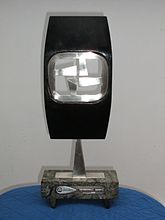Jacob's Awards
| Jacob's Award | |
|---|---|

Jacob's Television Award
|
|
| Awarded for | Outstanding contributions to Irish TV and radio |
| Country |
|
| Presented by | National newspaper TV and radio critics |
| First awarded | 1962 |
| Last awarded | 1993 |
The Jacob's Awards were instituted in December 1962 as the first Irish television awards. Later, they were expanded to include radio. The awards were named after their sponsor, W. & R. Jacob & Co. Ltd., a biscuit manufacturer, and recipients were selected by Ireland's national newspaper television and radio critics. Jacob's Award winners were chosen annually until 1993, when the final awards presentation took place.
Winners of a Jacob's Award include Fionnula Flanagan (1965), Gabriel Byrne (1979), and Brendan Gleeson (1992). The record for the most awards won is held by Gay Byrne, who was honoured six times between 1963 and 1981.
Telefís Éireann was launched as Ireland's first indigenous television station on 31 December 1961. Three months later, it was announced by W. & R. Jacob & Co. Ltd. that they intended to sponsor an award for outstanding contributions to the new medium.
On 4 December 1962, the first awards ceremony took place at the sponsor's headquarters in Dublin. There were nine winners, chosen by a panel of national newspaper television critics. Each winner received an award designed by the artist, Richard Kingston. This consisted of a silver St. Brigid's Cross mounted on a base of bog oak and Connemara marble.
The Jacob's Awards honoured teams of programme makers as well as individuals. For instance, in 1962, Telefís Éireann's Sports Department won an award for its general coverage during the station's first year of broadcasting. In 1965, a limit of eight annual awards was set, and the critics also decided not to confine themselves to fixed categories in making their selections.
A special "Golden Trophy" was introduced in 1966 to recognise exceptional performance. This was awarded every five years although it was dropped in the mid-1980s.
In 1969, the number of awards was increased to a maximum of thirteen in order to incorporate radio. A separate panel of national newspaper radio critics was formed to choose recipients of the new award, a highly polished, white metal cylinder designed by Robert Costelloe. This was replaced in 1981 by a trophy comprising a painted canvas mounted on a stainless steel background, designed by Theo McNab.
...
Wikipedia
